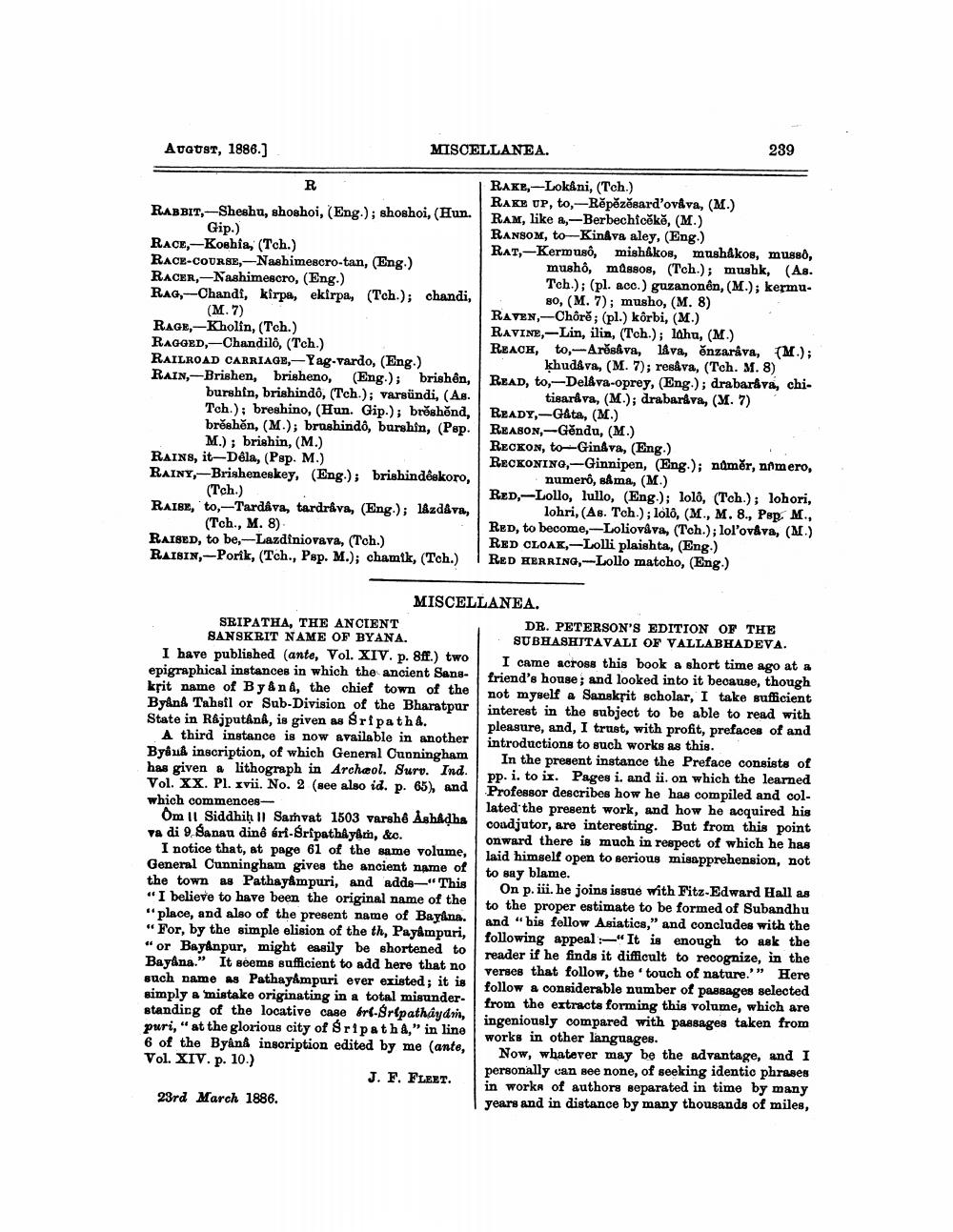________________
MISCELLANEA.
239
August, 1886.]
R
| RAKE,-Lokani, (Tch.)
RAKE UP, to,-Rěpězēsard'oviva, (M.) RABBIT,Shesha, shoshoi, (Eng.); shoshoi, (Hun.
RAM, like a, -Berbechicěkě, (M.) Gip.)
RANSOM, to-Kinava aley, (Eng.) RACE,-Koshia, (Tch.)
RAT,Kerm uso, mishákos, mushakos, muss, RACE-COURSE,-Nashimescro-tan, (Eng)
mushô, mesos, (Tch.); mushk, (As. RACER,-Nashimescro, (Eng.)
Tch.): (pl. acc.) guzanonen, (M.); kermuRAG,--Chandi, kirpa, ekirpa, (Toh.); chandi,
80, (M. 7); musho, (M. 8) (M.7)
RAVEN,-Chôrē; (pl.) körbi, (M.) RAGE,-Kholin, (Tch.)
RAVINE,-Lin, ilin, (Tch.); laha, (M.) RAGGED,-Chandilo, (Tch.)
REACH, to-Arosava, lava, önzaráva, (M.); RAILROAD CARRIAGE, -Yag vardo, (Eng.)
ķhudáva, (M. 7); resáva, (Tch. M. 8) RAIN-Brishen, brisheno, (Eng.); brishên, READ, to, --Delåva-oprey, (Eng.); drabaráva, chi. burshin, brishindo, (Tch.); varsündi, (As.
tisarkva, (M.); drabarkva, (M. 7) Tch.); breshino, (Hun. Gip.); brěshond, READY,- Gåta, (M.) brčahěn, (M.); brushindo, burshin, (Pep. REABON-Gěndu, (M.) M.) ; brishin, (M.)
Reckon, to-Gingva, (Eng.) RAINS, it-Déla, (Pep. M.)
RECKONING --Ginnipen, (Eng.); náměr, nímero, RAINY,Brisheneskey, (Eng.); brishindéskoro,
numero, s&ma, (M.) (Tch.)
RED,Lollo, lullo, (Eng.); lolô, (Tch.); lohori, RAIBE, to -Tardava, tardrava, (Eng.); låzdiva,
lohri, (As. Tch.); lolo, (M., M. 8., Pep M., (Tch., M. 8)
Red, to become, Lolioviva, (Tch.); lol'ováva, (M.) RAISED, to be --Lazdiniovava, (Toh.)
RED CLOAK,-Lolli plaishta, (Eng.) RAISIN, -Porik, (Tch., Psp. M.); chamik, (Tch.) RED HERRING,Lollo matcho, (Eng.)
MISCELLANEA. SRIPATHA, THE ANCIENT
DR. PETERSON'S EDITION OF THE SANSKRIT NAME OF BYANA.
SUBHASHITAVALI OF VALLABHADEVA. I have published (ante, Vol. XIV. p. 8ff.) two
I came across this book a short time ago at a epigraphical instances in which the ancient Sang- friend's house and looked into it because, though krit name of Byånd, the chief town of the not myself a Sanskrit scholar, I take sufficient Byana Tahsil or Sub-Division of the Bharatpur
interest in the subject to be able to read with State in Rajputana, is given as Sripatha.
pleasure, and I trust, with profit, prefaces of and A third instance is now available in another introductions to such works as this. Byaua inscription, of which General Cunningham
In the present instance the Preface consists of has given a lithograph in Archeol. Surv. Ind.
pp. i. to ix. Pages i. and ii. on which the learned Vol. xx. Pl. Ivii. No. 2 (see also id. p. 65), and Professor describes how he has compiled and colwhich commences
lated the present work, and how he acquired his Om 11 Siddhiḥ 11 Samvat 1503 varshê Ashadha coadjutor, are interesting. But from this point va di 9. Sanau dinê éri-SripathAy&, &c.
onward there is much in respect of which he has I notice that, at page 61 of the same volume,
laid himself open to serious misapprehension, not General Cunningham gives the ancient name of to say blame. the town as Pathayâmpuri, and adds—"This
On p. iii. he joins issue with Fitz-Edward Hall as "I believe to have been the original name of the
to the proper estimate to be formed of Subandhu "place, and also of the present name of Bayana.
and "bis fellow Asiatics," and concludes with the "For, by the simple elision of the th, Payampuri,
following appeal :-"It is enough to ask the " or Bayanpur, might easily be shortened to reader if he finds it difficult to recognize, in the Bayana.” It seems sufficient to add here that no verses that follow, the touch of nature.” Here such name as Pathayâmpuri ever existed; it is follow a considerable number of passages selected simply a mistake originating in a total misunder
from the extracts forming this volume, which are standing of the locative case brf-Srpatháydri,
ingeniously compared with passages taken from puri," at the glorious city of Sripath," in line
works in other languages. 6 of the ByAna inscription edited by me (ante,
Now, whatever may be the advantage, and I Vol. XIV. p. 10.)
personally can see none, of seeking identio phrases J. F. FLEET.
in works of authors separated in time by many 23rd March 1886.
years and in distance by many thousands of miles,




